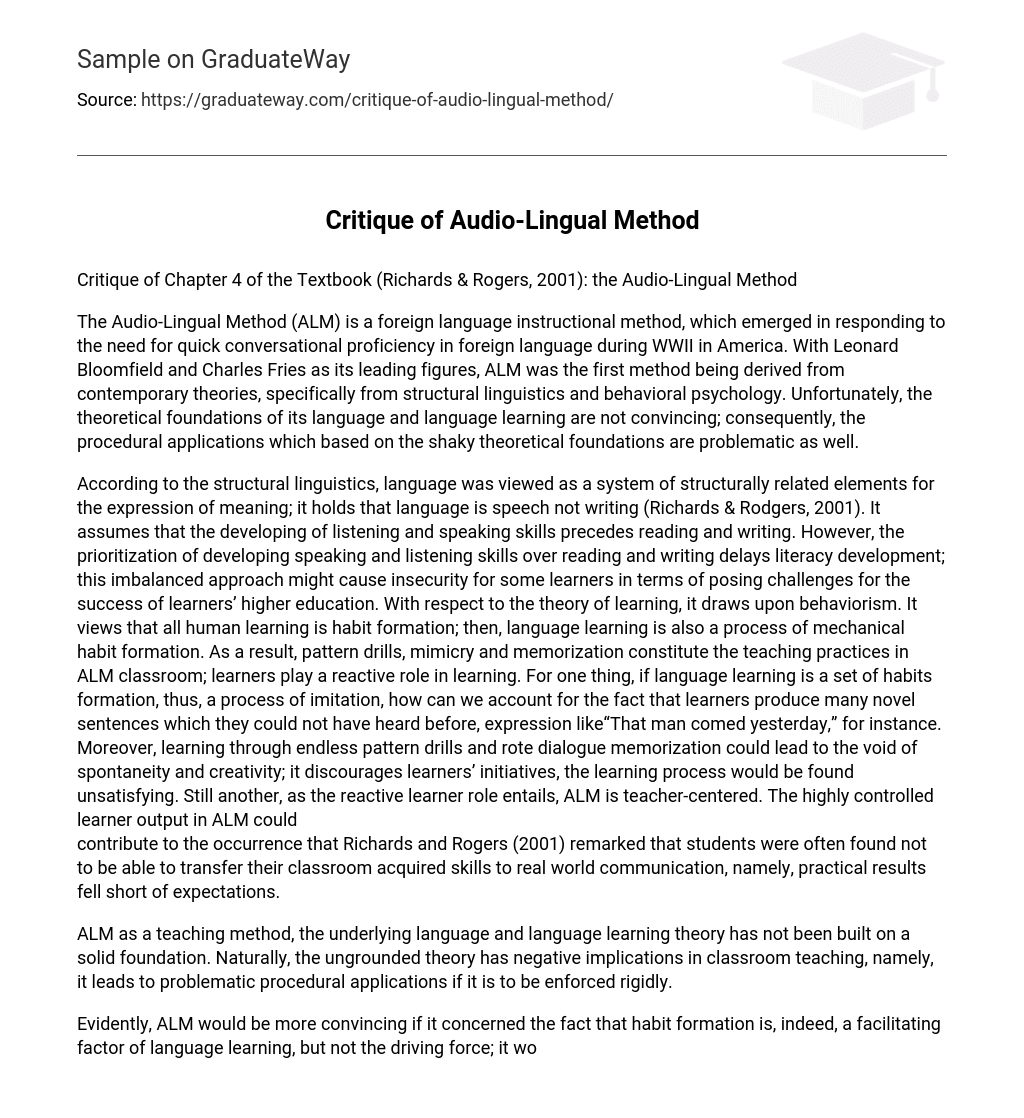The Audio-Lingual Method (ALM) is a foreign language instructional method, which emerged in responding to the need for quick conversational proficiency in foreign language during WWII in America. With Leonard Bloomfield and Charles Fries as its leading figures, ALM was the first method being derived from contemporary theories, specifically from structural linguistics and behavioral psychology. Unfortunately, the theoretical foundations of its language and language learning are not convincing; consequently, the procedural applications which based on the shaky theoretical foundations are problematic as well.
According to the structural linguistics, language was viewed as a system of structurally related elements for the expression of meaning; it holds that language is speech not writing (Richards & Rodgers, 2001). It assumes that the developing of listening and speaking skills precedes reading and writing.
However, the prioritization of developing speaking and listening skills over reading and writing delays literacy development; this imbalanced approach might cause insecurity for some learners in terms of posing challenges for the success of learners’ higher education. With respect to the theory of learning, it draws upon behaviorism. It views that all human learning is habit formation; then, language learning is also a process of mechanical habit formation.
As a result, pattern drills, mimicry and memorization constitute the teaching practices in ALM classroom; learners play a reactive role in learning. For one thing, if language learning is a set of habits formation, thus, a process of imitation, how can we account for the fact that learners produce many novel sentences which they could not have heard before, expression like“That man comed yesterday,” for instance.
Moreover, learning through endless pattern drills and rote dialogue memorization could lead to the void of spontaneity and creativity; it discourages learners’ initiatives, the learning process would be found unsatisfying. Still another, as the reactive learner role entails, ALM is teacher-centered. The highly controlled learner output in ALM could contribute to the occurrence that Richards and Rogers (2001) remarked that students were often found not to be able to transfer their classroom acquired skills to real world communication, namely, practical results fell short of expectations.
ALM as a teaching method, the underlying language and language learning theory has not been built on a solid foundation. Naturally, the ungrounded theory has negative implications in classroom teaching, namely, it leads to problematic procedural applications if it is to be enforced rigidly.
Evidently, ALM would be more convincing if it concerned the fact that habit formation is, indeed, a facilitating factor of language learning, but not the driving force; it would be more effective if explicit grammatical instruction were given with some native language involvement; it would be more productive if it developed four skills in a more balanced fashion; it would be more appealing if the classroom activities were less teacher-dominated and more analytical processing demanding.
To conclude, although ALM formulated its own distinctive characteristics by historically drawing upon structural linguistics and behavioral psychology, the underlying language and language learning theory cannot stand its ground while under scrutiny. Imitation and practice are not the only contributing factors of language learning; Excessive pattern drills and rote memorizations are not cognitive process encouraging. The over emphasis on the mechanic aspects of language learning and language use is lopsided.
References List
- Richards, J.C., and T.S. Rodgers (2001). Approaches and Methods in Language Teaching 2nd edn. New York: Cambridge University Press.





